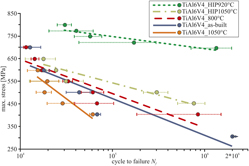Crossref Citations
This article has been cited by the following publications. This list is generated based on data provided by
Crossref.
Leuders, Stefan
Vollmer, Malte
Brenne, Florian
Tröster, Thomas
and
Niendorf, Thomas
2015.
Fatigue Strength Prediction for Titanium Alloy TiAl6V4 Manufactured by Selective Laser Melting.
Metallurgical and Materials Transactions A,
Vol. 46,
Issue. 9,
p.
3816.
Song, Bo
Zhao, Xiao
Li, Shuai
Han, Changjun
Wei, Qingsong
Wen, Shifeng
Liu, Jie
and
Shi, Yusheng
2015.
Differences in microstructure and properties between selective laser melting and traditional manufacturing for fabrication of metal parts: A review.
Frontiers of Mechanical Engineering,
Vol. 10,
Issue. 2,
p.
111.
Lewandowski, John J.
and
Seifi, Mohsen
2016.
Metal Additive Manufacturing: A Review of Mechanical Properties.
Annual Review of Materials Research,
Vol. 46,
Issue. 1,
p.
151.
Li, P.
Warner, D.H.
Fatemi, A.
and
Phan, N.
2016.
Critical assessment of the fatigue performance of additively manufactured Ti–6Al–4V and perspective for future research.
International Journal of Fatigue,
Vol. 85,
Issue. ,
p.
130.
Li, Peipei
Warner, Derek
Fatemi, Ali
and
Phan, Nam D.
2016.
On the Fatigue Performance of Additively Manufactured Ti-6Al-4V to Enable Rapid Qualification for Aerospace Applications.
Smith, Jacob
Xiong, Wei
Yan, Wentao
Lin, Stephen
Cheng, Puikei
Kafka, Orion L.
Wagner, Gregory J.
Cao, Jian
and
Liu, Wing Kam
2016.
Linking process, structure, property, and performance for metal-based additive manufacturing: computational approaches with experimental support.
Computational Mechanics,
Vol. 57,
Issue. 4,
p.
583.
Beese, Allison M.
and
Carroll, Beth E.
2016.
Review of Mechanical Properties of Ti-6Al-4V Made by Laser-Based Additive Manufacturing Using Powder Feedstock.
JOM,
Vol. 68,
Issue. 3,
p.
724.
Witkin, David B.
Albright, Thomas V.
and
Patel, Dhruv N.
2016.
Empirical Approach to Understanding the Fatigue Behavior of Metals Made Using Additive Manufacturing.
Metallurgical and Materials Transactions A,
Vol. 47,
Issue. 8,
p.
3823.
Lammers, Stefan
Adam, Guido
Schmid, Hans J.
Mrozek, Rafael
Oberacker, Rainer
Hoffmann, M. J.
Quattrone, Francesco
and
Ponick, Bernd
2016.
Additive Manufacturing of a lightweight rotor for a permanent magnet synchronous machine.
p.
41.
Wu, Ming-Wei
and
Lai, Pang-Hsin
2016.
The positive effect of hot isostatic pressing on improving the anisotropies of bending and impact properties in selective laser melted Ti-6Al-4V alloy.
Materials Science and Engineering: A,
Vol. 658,
Issue. ,
p.
429.
Brüggemann, Jan-Peter
Reschetnik, Wadim
Richard, Hans A
Kullmer, Gunter
and
Schramm, Britta
2016.
Rapid.Tech – International Trade Show & Conference for Additive Manufacturing.
p.
290.
Grienitz, Volker
Tröster, Thomas
and
Meiners, Stefan
2016.
Selektives Laserschmelzen für Leichtbau mit Designfreiheit.
Lightweight Design,
Vol. 9,
Issue. 3,
p.
82.
Morita, Tatsuro
Tsuda, Chika
Sakai, Hitoshi
and
Higuchi, Norio
2017.
Fundamental Properties of Ti-6Al-4V Alloy Produced by Selective Laser Melting Method.
MATERIALS TRANSACTIONS,
Vol. 58,
Issue. 10,
p.
1397.
Ellyson, Benjamin
Brochu, Mathieu
and
Brochu, Myriam
2017.
Characterization of bending vibration fatigue of SLM fabricated Ti-6Al-4V.
International Journal of Fatigue,
Vol. 99,
Issue. ,
p.
25.
Lammers, S.
Quattrone, F.
Mrozek, R.
Zimmer, D.
Schmid, H.
Ponick, B.
and
Hoffmann, M.
2017.
Rapid.Tech – International Trade Show & Conference for Additive Manufacturing.
p.
80.
Leuders, S.
Meiners, S.
Wu, L.
Taube, A.
Tröster, T.
and
Niendorf, T.
2017.
Structural components manufactured by Selective Laser Melting and Investment Casting—Impact of the process route on the damage mechanism under cyclic loading.
Journal of Materials Processing Technology,
Vol. 248,
Issue. ,
p.
130.
Hengsbach, Florian
Koppa, Peter
Duschik, Kristina
Holzweissig, Martin Joachim
Burns, Madison
Nellesen, Jens
Tillmann, Wolfgang
Tröster, Thomas
Hoyer, Kay-Peter
and
Schaper, Mirko
2017.
Duplex stainless steel fabricated by selective laser melting - Microstructural and mechanical properties.
Materials & Design,
Vol. 133,
Issue. ,
p.
136.
Zhang, Bi
Li, Yongtao
and
Bai, Qian
2017.
Defect Formation Mechanisms
in Selective Laser Melting: A Review.
Chinese Journal of Mechanical Engineering,
Vol. 30,
Issue. 3,
p.
515.
Yadollahi, Aref
and
Shamsaei, Nima
2017.
Additive manufacturing of fatigue resistant materials: Challenges and opportunities.
International Journal of Fatigue,
Vol. 98,
Issue. ,
p.
14.
Brüggemann, Jan-Peter
Risse, Lena
Kullmer, Gunter
and
Richard, Hans Albert
2017.
Rapid.Tech – International Trade Show & Conference for Additive Manufacturing.
p.
94.



